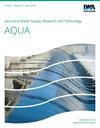利用遥感和基于gis的机器学习方法识别Idukki地区地下水潜力带
IF 4.3
Q2 Environmental Science
引用次数: 0
摘要
喀拉拉邦的伊杜基地区位于印度的西高止山脉,容易受到洪水和山体滑坡的影响。由于2018年喀拉拉邦的洪水,这个易发灾害的地区经历了干旱。为了减轻未来灾害的影响,还需要对该地区的地下水潜力(GWP)进行识别和评估。这项工作使用了三种机器学习(ML)算法——随机森林(RF)、自适应增强(AdaBoost)和梯度增强(GB)——来建模并生成Idukki地区的全球升温幅度分区图。14个调节因子包括海拔、坡度、曲率、地形粗糙度指数、线条密度、土壤、地质、地貌、地形湿度指数、沉积物输送指数、排水密度、降雨量、土地利用/土地覆盖(LULC)和归一化植被差异指数,这些因子被用作建模的输入参数。当使用递归特征消除(RFE)方法检查特征重要性时,所有特征都显示出突出性。RF模型的拟合效果优于其他两种ML模型,曲线下面积(AUC)值为0.92,而GB和AdaBoost模型的拟合效果较差,AUC值分别为0.90和0.88。每个模型生成的GWP地图被重新划分为5个区域——非常高到非常低——发现这些区域均匀地分布在整个Idukki地区。本文章由计算机程序翻译,如有差异,请以英文原文为准。
Identification of groundwater potential zones of Idukki district using remote sensing and GIS-based machine-learning approach
Kerala's Idukki district, which is situated on the Western Ghats of India, is susceptible to flooding and landslides. As a result of the 2018 Kerala floods, this disaster-prone region experienced drought conditions. In order to lessen the effects of future disasters, it is also necessary to identify and evaluate the district's groundwater potential (GWP). This work used three machine-learning (ML) algorithms – Random Forest (RF), Adaptive Boosting (AdaBoost), and Gradient Boosting (GB) – to model and produce GWP zonation maps for the Idukki district. Fourteen conditioning factors include elevation, slope, curvature, Topographic Roughness Index, lineament density, soil, geology, geomorphology, Topographic Wetness Index, Sediment Transport Index, drainage density, rainfall, land-use/land-cover (LULC), and Normalised Difference Vegetation Index that were adopted as input parameters in the modelling. All showed prominence when they were examined for feature importance using the recursive feature elimination (RFE) method. The RF model outperformed the other two ML models in terms of fit, with an area under curve (AUC) value of 0.92, while the GB and AdaBoost models displayed less fit, with AUC values of 0.90 and 0.88, respectively. GWP maps produced by each model were reclassified into five zones – very high to very low – it was discovered that the zones were evenly spread throughout the Idukki region.
求助全文
通过发布文献求助,成功后即可免费获取论文全文。
去求助
来源期刊
CiteScore
4.70
自引率
0.00%
发文量
74
审稿时长
4.5 months
期刊介绍:
Journal of Water Supply: Research and Technology - Aqua publishes peer-reviewed scientific & technical, review, and practical/ operational papers dealing with research and development in water supply technology and management, including economics, training and public relations on a national and international level.

 求助内容:
求助内容: 应助结果提醒方式:
应助结果提醒方式:


